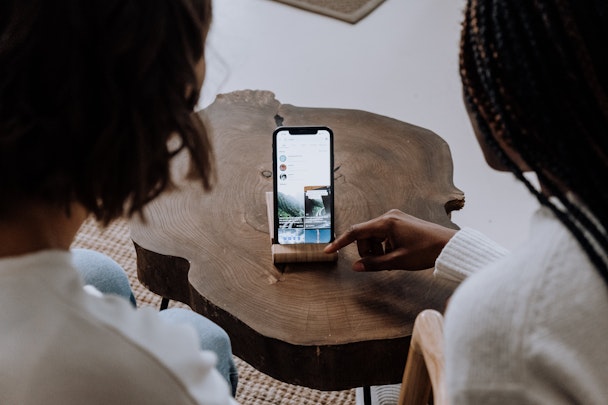Content’s no longer King, format is – here are 3 tips to get it right
With the rise of podcasts and reels, here’s why marketers should pay attention to format—and why social media is killing the game in modern day storytelling.

Over the holidays, I got caught in the TikTok rabbit hole and glued myself to watching Royal Caribbean’s ‘nine-month world cruise’ on social media. For those unaware, it’s a modern tale of injustice that started from a viral video posted by Brandee Lake, an African American female passenger constantly mistaken as a cruise ship worker by premium guests and crew.
Where content aims to answer the “what,” storytellers these days focus on “how” a story is being told using formats. Let me make this clear: content and format are both important; it just happens that “good content” today is a minimum expectation.
What captivated me with Royal Caribbean was the ability to watch the saga unfold from multiple perspectives - whether it’s the people on board or the content creators on land, with one influencer even doing an “Ultimate World Cruise Bingo” edition as a way to tick off the shade that went down. However, among these iterations, each was a standalone experience and it was up to the audience, just like myself, to choose their own adventure.
So what exactly is a “format”? Well, it depends on who you speak to
Prior to Media.Monks, I worked in television and if Royal Caribbean were a hit reality show, Brandee Lake would have to deal with network execs, which is another type of injustice (but she’ll at least get an appearance on Dancing With The Stars). You may be wondering why I’m comparing traditional versus social media, but we can learn a few things from this approach. Why? Because everyone in television is obsessed with formats.
Advertisement
A “format” in TV terms is original programming with international or spin-off versions. So a broadcaster or production company would buy the “Idol” format (i.e., American Idol), which grants them the right to commission a “Junior Idol” or “Australian Idol” version of the franchise. Buying a TV format also gets the classic “format bible,” which is a big fancy production manual with step-by-step instructions on how exactly an episode is created with the desired look and feel, from set design, scripting, stage lighting, all the way to casting and crew hiring strategies. Think of this as your grandma's secret recipe, but instead of that special ingredient being “tender love and care,” it’s, yep, format.
Because television is only limited to video, social media companies have taken on more of a media-centric approach when defining formats, meaning static images (like photos), animated gifs, podcasts, and AR filters are just some of the many exciting formats available for content creators and brands to use in storytelling. TV formats shed light on branding and consistency, but social media has taken storytelling conventions to a whole new level, all thanks to formats. What’s a true crime story on TV can now be told on social media as a mukbang challenge or a “get ready with me” make-up tutorial.
We also see a paradigm shift in social platforms trying to own formats. Instagram Reels and YouTube Shorts have aggressively been promoting their unique sets of creative strengths regarding vertical videos. However, TikTok has recently announced their plans of launching branded segments as original IP. In the race to find that winning formula, here are three things brand marketers and content creators can do to ensure the format is always in check when it comes to storytelling.
1. Have an updated playbook
Social playbooks are the guardian angels of the digital galaxy, and more brands are now using them for the purpose of storytelling. They’re a record of rules that capture content pillars and platform guidelines - extremely useful when making creative and editorial decisions. Because social is so dynamic, it’s ideal to have your social playbook reviewed occasionally to ensure you have the latest formats on standby based on what platforms are prioritizing and rolling out.
2. Track trends in real-time
Even though you have a framework, formats can also be impacted by current social media trends. Just on TikTok alone, your craft can change overnight because of a content trend, trending audio, popular comments, video reactions, cultural moments, etc. Ensuring you create an engine of insights that can track trends in real-time, allowing you to decipher which conversations you want to be part of and the best way to get your message across, is essential.
Advertisement
3. Nail that brief
There’s a view in television that producing an episode from a “proven format” such as Idol or MasterChef outweighs the risk of producing an original singing or cooking show idea from scratch, which is why producers invest a lot more time in development and pre-production stages. Regardless of jumping on an existing trend or trying out something new, social media is no exception and the brief is worth more than the final output.
Now that I work for Media.Monks — which includes global social media expertise within its wide range of digital marketing services — approximately two-thirds of our clients would prefer to write the brief collaboratively instead of traditionally emailing it as a PDF, mainly due to the fear of requesting for something completely out of touch.
With a playbook, an insights engine, and the right format from a well-developed brief, you’re all set to make great social content and epic stories - gearing your secret sauce for success as the ultimate social storyteller in 2024.
Suggested newsletters for you
Content by The Drum Network member:

Media.Monks
About Media.Monks
Media.Monks is a digital-first marketing and advertising services company that connects content, data&digital media and technology services...

